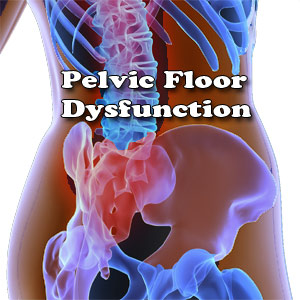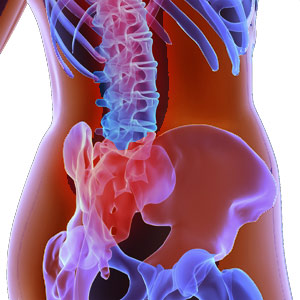Pelvic Floor Dysfunction

The pelvic floor muscles and other tissues form a sling-like structure that supports the pelvic organs like the bladder, prostate, uterus and rectum. Pelvic muscles assist in support of abdominal and pelvic organs, control or bladder and bowel movements and sexual activity. Vaginal pain or pressure or pain in the bladder or rectum is not normal. Pelvic floor dysfunction in men is also called as Prostatodynia (painful prostate). This condition may cause erectile dysfunction in men.
The cause for pelvic pain is often difficult to diagnose. Tissues around the pelvic organs might suffer increased or reduced sensitivity or irritation leading to pain in the area. Pelvic floor disorders can manifest as urinary incontinence or fecal incontinence. Typical pelvic disorders include interstitial cystitis, pelvic inflammatory disease or digestive disorders such as diverticulitis and colitis. Cystitis, irritable bowel syndrome, pelvic congestion and vulvovaginitis are other pelvic conditions that lead to pelvic pain. Infections, pregnancy and childbirth, incorrect posture, trauma or surgery can lead to pain in the pelvic area.
Symptoms in Women:
- Frequent urination with incomplete sensation
- Pelvic pain
- Pain in the lower back and behind the vagina
- Constipation
- The feeling of incomplete bowel movement
- Constipation or strain during bowel movement
- Vaginal or rectal prolapse (sagging of the vagina or rectum)
- Rectocele (protrusion of the rectum into the vagina)
- Cystocele ( herniation of the bladder into the vagina)
- Enterocele (a herniation of the intestine into the vagina)
- Sigmoidocele (a herniation of the sigmoid colon into the vagina)
- A common pelvic disorder with women is endometriosis. Fibromyalgia (extensive musculoskeletal pain) , Dysmenorrhea (painful periods) and Dyspareunia (painful coition) are other disorders that result in severe and chronic pelvic pain.
Symptoms in Men:
- Urgency and frequency in urination
- Lower back pain
- Pain in testes and pain on ejaculation
- Reduced urinary flow
- Constipation
- Levator Ani Syndrome (pressure and pain in the sacrum)
- The feeling of incomplete bowel movement
- Constipation or strain during bowel movement
Pelvic floor dysfunction diagnosis
Individual symptoms and history is studied. The physician carries out a physical examination to identify any abnormalities. Other symptoms such as unexplained weight loss, abnormal vaginal bleeding and hematochezia (passing of fresh blood through the anus) must be observed.
Proctogram is a study employed to understand the functional problems in a person with pelvic floor dysfunction. A thick liquid that can be detected with x-ray is induced as enema to the patient. The x-ray records the movement of the pelvic floor muscles and the rectum while the patient tries to empty the liquid from the rectum.
In patients suffering from pelvic floor dysfunction, the pelvic floor muscles do not relax and the passage of the liquid becomes difficult. In a normal person the liquid passes through easily as the muscles relax well.
The proctogram procedure also helps in understanding rectum prolapse (if rectum is folding in by itself). In patients suffering from rectocele (pouching of the rectum) stool gets trapped in this area and proctogram helps understand this better.
Pelvic floor dysfunction causes
The exact cause for pelvic floor dysfunction remains unknown. However causes may include obesity, pregnancy, childbirth and menopause. Accidents involving the pelvic area may also cause this condition. A study also suggests that women with congenitally weak connective tissues and fascia may face a high risk of pelvic floor disorders. In men, the major causes for this condition include weight lifting, obesity, surgery and constipation etc.
Treating pelvic disorders
Biofeedback: Biofeedback is a well-known therapy for people suffering from non-relaxation of the pelvic floor muscles. About 75% of patients suffering from pelvic floor dysfunction improve with biofeedback therapy. This specialized therapy helps the patient gain better rectal sensation and pelvic floor muscle coordination. Therapists also adopt the technique of placing a balloon in the rectum to expel the stools.
Electrical stimulation: In another technique a probe is placed in the vagina or rectum, the electrodes are placed around the opening of the rectum on the surface of the skin and on the abdominal wall. The instruments detect the muscle while contracting or relaxing and provide visual feedback of the muscle action. The visual feedback will help the patient recognize the muscle movement and learn to coordinate the muscle movement.
Relaxation technique: Relaxation techniques such as warm bath, sitz baths, yoga and exercise may be suggested by the therapist. Avoid sitting for long hours at a stretch. Keep active and walk often. Add sufficient fiber in your diet to avoid constipation.
Medication: A low-dose muscle relaxant as prescribed by the physician may help relieve the condition.
Surgery: Rectal prolapse and rectocele may be treated through surgery. Rectal prolapse occurs when the tissue that lines the rectum falls down into the anal opening. Rectocele occurs in women when the wall of the vagina is pushed through into by the end of the rectum. The proctogram test helps the physician determine if these conditions are the cause for the pelvic floor dysfunction.
Cold laser: Cold laser involves a process wherein low-intensity laser light is applied to the tissue and this eases out the pain and inflammation.
Top of the Page: Pelvic Floor Dysfunction
Tags:#pelvic floor dysfunction #pelvic floor disorder
 Pelvic Floor Dysfunction
Pelvic Floor Dysfunction Bladder problems in women
Urinary Incontinence
UTI - Urinary Tract Infection
Feminine Hygiene
Yeast Allergy
Other health topics in TargetWoman Women Health section:
General Women Health

Women Health Tips - Women Health - key to understanding your health ...
Cardiac Care
Women's Heart Attack Symptoms - Identify heart problems...
Skin Diseases
Stress Hives - Red itchy spots ...
Women Disorders
Endocrine Disorder - Play a key role in overall wellbeing ...
Women's Reproductive Health
Testosterone Cream for Women - Hormone replacement option ...
Pregnancy
Pregnancy - Regulate your lifestyle to accommodate the needs of pregnancy ...
Head and Face
Sinus Infection - Nearly 1 of every 7 Americans suffer from ....
Women and Bone Care

Slipped Disc - Prevent injury, reduce pain ...
Menstrual Disorders
Enlarged Uterus - Uterus larger than normal size ...
Female Urinary Problems
Bladder Problems in Women - Treatable and curable ...
Gastrointestinal Disorders
Causes of Stomach Ulcers - Burning feeling in the gut ...
Respiratory Disorders
Lung function Test - How well do you breathe ...
Sleep Management

Insomnia and Weight Gain - Sleep it off ...
Psychological Disorders in Women
Mood swings and women - Not going crazy ...
Supplements for Women
Women's Vitamins - Wellness needs...
Natural Remedies

Natural Diuretic - Flush out toxins ...
Alternative Therapy
Acupuncture Point - Feel the pins and needles ...
Women Health Directory
Top of the Page: Pelvic Floor Dysfunction
Popularity Index: 103,567

